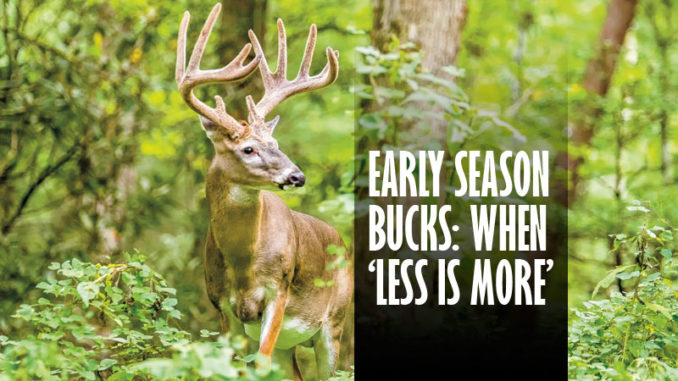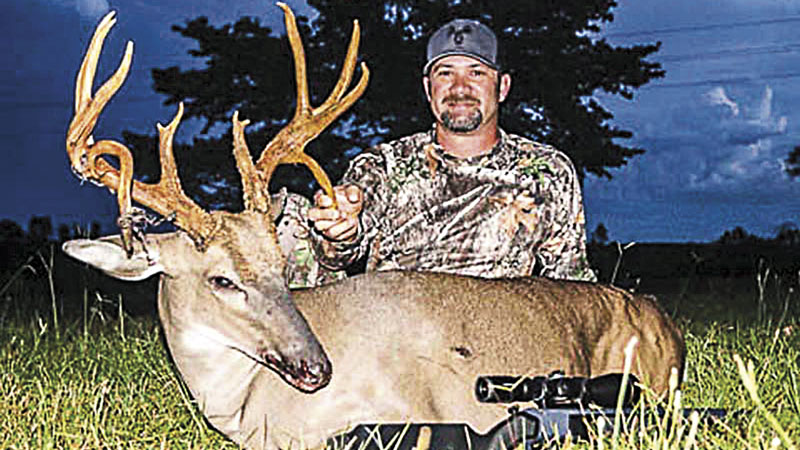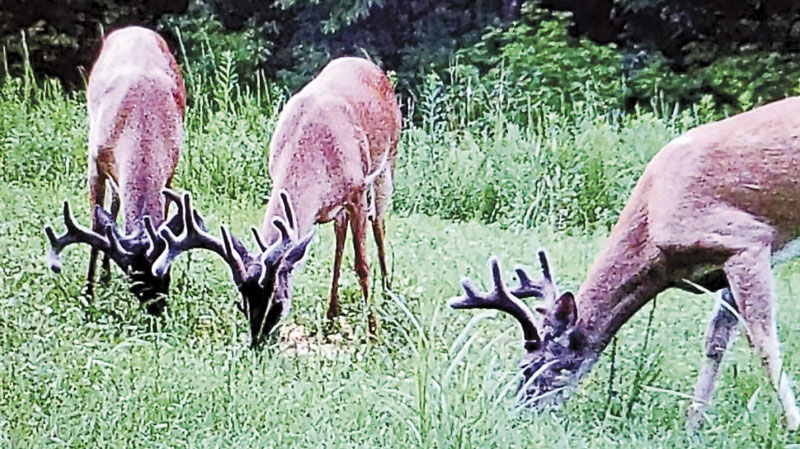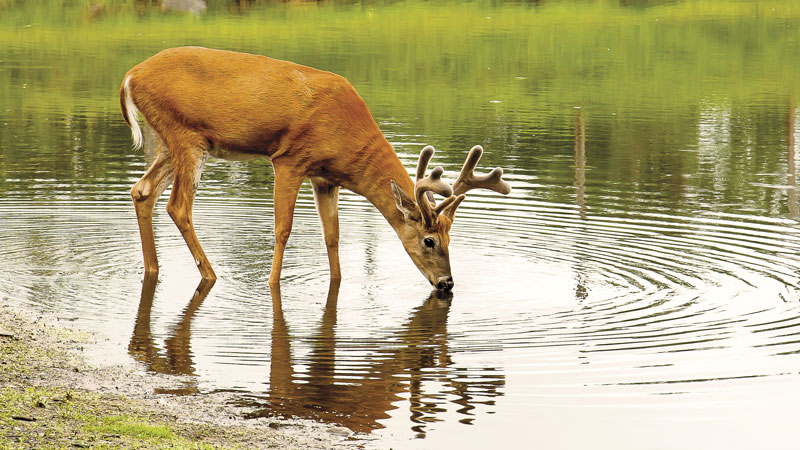
Once you pinpoint the buck you want to hunt when the season arrives, stay the heck out of the place where you expect to kill him.
English teachers call them oxymorons — the joining of two words or phrases that would seem to be contradictions.
Like, for instance, “jumbo shrimp.”
Heath Rayfield’s approach to early season deer hunting would seem to be an oxymoron.
“Less is more.”
But it might just be a key for deer hunters in the Carolinas who want to put a big buck in their sights as soon as their season opens — be it a mid-August gun season in South Carolina’s Lowcountry or North Carolina’s statewide bow season one week into September.
“What I mean is, the less intrusive you are in an area you’re planning to hunt, the better off you are when it comes time to try and kill him,” said Rayfield, who guides hunters at Buchanan Shoals Sportsman’s Preserve (704-695-2810) outside of Morven, N.C., a tiny community in the southern part of Anson County. “The first time you sit in your stand, that’s the best chance you’re going to have to kill him.”
Be selective about when you check your trail cameras
Rayfield relies on trail cameras set up in areas where he’s feeding corn, or where he’s got a good food plot in the ground, to figure out what kinds of bucks are at home on the piece of property he’s watching.
“If I have the opportunity to sit for an hour or two and glass a big beanfield, yeah, I’ll do that, and you’ll have a chance to kill the bucks you see. But most of the time, we’re hunting in the woods or around food plots.
“I don’t check my trail cameras until Aug. 1, then I sneak in, pull the SD cards when I’m putting out corn, and sneak back out,” he said. “After about Aug. 15, I’ll check my cameras every two weeks, and if I can’t check them between 11 a.m. and 2 p.m., when the wind is right, I’ll wait until a day when I can.
“If I get some good bucks on a trail camera where I don’t have a stand, I’ll wait and go in and hang it in the middle of the day, unless I know he’s going to a big field at night, and he’s going to stay all night; then, I’ll go in and hang it at night, close to his bedding area, so I’ve got a better chance of getting in and out without bumping him.”
Rayfield’s strategy is a proven method
Rayfield has two perfect examples of how his strategy works. The first was a big buck he killed several years ago in Missouri; the second was a big buck with double drop tines he had on a trail camera on a 33-acre piece of property in Chesterfield County, S.C., consistently coming to one area.
“I had a five-day hunt in Missouri, and I spent the first two days just glassing,” he said. “I gave up the first two days of hunting to glass. But I saw him, and I saw the right tree, and on the third day, at 11 a.m., I went in and hung my stand. I was back out in the stand at 3:30, and I killed him that afternoon.

“The big buck with the drop tines, I had him on camera the 22nd, 23rd and 25th (of August), and I never went back to the stand where I wanted to kill him until a few days before (Sept. 5),” he said. “I rode in on a tractor, and a dumped corn and a bag of 4S Draw out of the bucket, and I left without setting foot on the ground.
“I waited until the wind was right for that stand, and when I came back and sat the first time (Sept. 8), I killed him.”
Eearly-season patterns won’t change unless bucks are disturbed
Rayfield said hunters can count on bucks, especially those operating in a bachelor group, to keep doing the same things, at the same times, from about Aug. 1 until the time when they rub the velvet from their antlers and go their own way. That is, unless they’re disturbed by a hunter tromping around in their territory.
“He’s not gonna change his pattern until he loses his velvet. From Aug. 15 to Sept. 15, those bucks are 100% in bachelor groups and on a food pattern. If a big buck is in a bachelor group, you are hunting that group. They won’t break up until they shed their velvet. They will bed together and travel together as a group.”
“Once I get them on camera, I go to the house and put a game plan together, and I stay out of the place where I want to kill him.”
Rayfield, who owns Thompson’s Creek Deer Processing in Chesterfield, S.C., said one thing many hunters fail to understand when looking for a place to set up along the route an early season buck takes from his bedding area to his feeding area is that, in most parts of the Carolinas, he won’t bed in the usual thick cover where you find him the rest of the season.
Look for bucks in open areas with good visibility
“Early in the season, a big buck would rather lay down on a big, wide open hardwood ridge than in a thicket,” he said. “He’ll get on top of a ridge, where he can see everything and has plenty of escape routes, where he can get in the shade, and where it’s cooler than in a thicket, where there’s no wind stirring. A bachelor group will roost on an open, hardwood ridge. “Sometimes, you’ll find a big buck laying down in the middle of a big beanfield. That’s because he’s hidden and he can get a good breeze.”

Admire From Afar
Veteran hunter Will McElveen of Andrews, S.C., uses typical scouting techniques employed by many hunters, but he also does a few things differently.
“Bucks are very wary all the time, so I use great care when scouting,” he said. “I’ll slip into the swamps during mid-day to look for sign in funnels along thickets and the edge of creeks and swamp runs. I’ll use trail cameras, as well, but I only check them occasionally to ensure I don’t intrude too much. When I find what I want, I’ll pick my stand site and stay out until I hunt that spot.”
But he has another technique that helps him target bucks in the areas he hunts.
“I’m fortunate to hunt in an area with a lot of fields, as well as thickets and swamps,” McElveen said.
“While bucks won’t always come out until dark, often they do, especially in the early season. I do drive-bys in my truck, looking for bucks in soybean and peanut fields. They’ll be in corn fields, but you can’t see them until those fields are cut. But I am very careful and methodical about this tactic. As I drive down a paved road or a dirt road that winds though the fields, I look into the far-off corners and edges in the late afternoon and frequently use binoculars.
Keep your distance when scouting early season bucks
“My target is to see a nice buck several hundred yards away. When I do, I mark where I see him, then I leave without spooking him. I’ll come back mid-day the next day and slip in to the spot where I saw him. I wear rubber boots and no-scent clothing, and usually it’s pretty easy to see where they are exiting the woods and walking into a the field to feed.”
“I pick a stand site and will be back with my climber when the wind is right. I’ll get there early, climb high and often will see the buck or sometimes several bucks. “That’s when the hard work pays off.” — Terry Madewell

Keep an eye on the water
Even though fall arrives in September, the thermometer tells a different story. Average daily temperatures remain on the hot side for most of the month, and wildlife are still hovering near one of their most vital assets, water.
Hunters can target stable water sources early in deer season. They’ll find them being routinely used by all types of wildlife, including groups of bachelor bucks.
Water holes can be everything from a winding creek, river, lake or swamp to something man-made like a ditch, a relic mining operation or a secluded farm pond. When it’s hot, deer and other wildlife make a daily visit to water sources, without exception. When water availability is limited, it will bring in wildlife better than a prime food source.
Don’t overlook watering holes
T.J. Hallman, who manages a commercial hunting operation in South Carolina’s Midlands area, believes water sources are critical for deer late in the summer when the weather is sweltering hot.
“Heat coincides with the early season, and water is a huge factor when it comes to a deer’s health. Food, water and cover are the three essentials — water being the most important during those hot summer months,” said Hallman, who likes to hunt near or over water sources when it’s hot.
“It’s a tactic that helps ease those buck-fever feelings because you typically see a lot of wildlife, but it can pay off big dividends with an unsuspecting trophy shows up traveling with his other bachelor pals.”
The best water sources are places adjacent to bedding sites and feeding areas. Deer cannot visit a water source without leaving a trace of some kind in terms of tracks and trails. Hallman not only monitors water sources, he investigates the trails leading to and from them to identify places to set up.
“We have lots of drainages that create natural travel avenues to the water’s edge,” Hallman said. “We travel the (Saluda) river time and time again, marking trails that come down to the water, follow the trail back to find where it originates, and set up to and from that frequent water source visitation.” — Jeff Burleson

